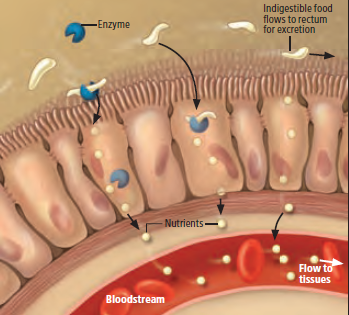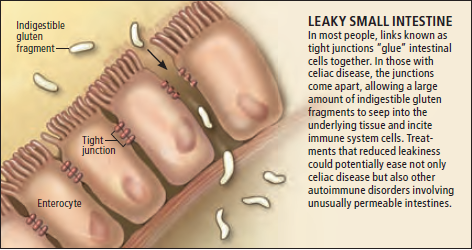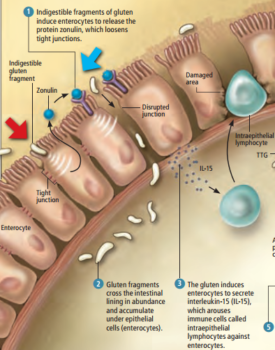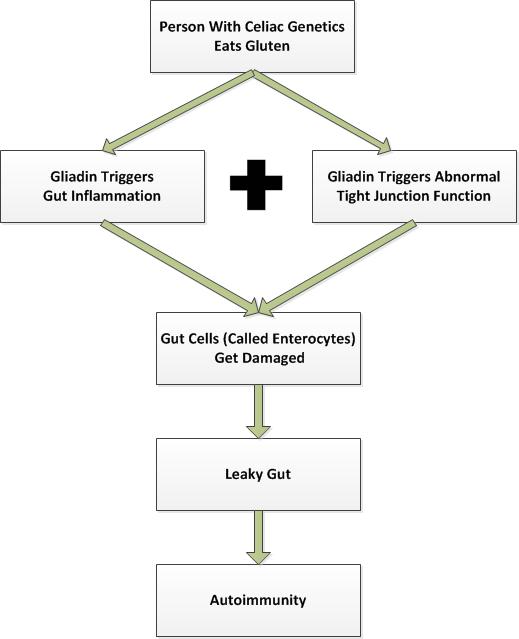How Gluten Causes Celiac Disease

When I was a kid, I was afraid of Ghosts.
I used to lay in bed paralyzed with fear, thinking they were hiding in every dark corner of my room. I eventually got over it by sleeping with the lights on.
We humans fear what we don’t know… and I was mostly just afraid of the dark.
Things weren’t much different when I was diagnosed with Celiac Disease in 2007. I knew I needed to make a drastic gluten-free change in my life but I felt paralyzed with fear. It was time to face my disease… or let it stay hidden in the dark.
I chose to turn the lights on by learning how gluten caused my disease.
And in this article, I’m going to share it with you…
Celiac Disease Triggers a War Inside Your Body
Celiac Disease is an autoimmune disease. Autoimmune diseases “arise from inappropriate immune response of the body against substances and tissues normally present in the body.”[1]
I really like that word “inappropriate“… I agree it’s inappropriate that my immune system, which is supposed to protect me from the outside world, is actually mistaking some part of my body as an evil pathogen and attacking my healthy tissue.
Under normal conditions, the immune system is designed to protect us from bad guys (called antigens) like toxins, bacteria, viruses, cancer cells, etc. When these antigens come in contact with our body the immune system is equipped to wage war and defend our home territory.
In people with autoimmune disease, the immune system gets “confused” about what’s an antigen and what’s our own healthy body tissue, recognizing it as a threat and destroying it… it’s a tragic case of mistaken identity.
So, when people with Celiac Disease eat foods that contain gluten, their immune system is uniquely programmed to recognize it as a threat and react by damaging the tissue lining the small intestine, called villi. That’s when things get “inappropriate.” The immune system thinks it’s doing a good job keeping us safe, but it’s destroying our healthy gut lining in an all-out nuclear war.
Tiny villi lining the gut take the brunt of the attack. During normal operation, these tiny villi are responsible for absorbing nutrients from our food. But over time, these long finger-like structures get destroyed to the point of flattened out stubs.
The villi destruction looks like this:
Image source: “Celiac disease: diagnostic criteria in progress”
Do these flattened out stubs look like they can absorb nutrients and “good stuff” very well? What about protecting you from the bad guys?
Because as it Turns Out, You’re Hollow on the Inside
That’s right… from the mouth to the anus – we humans have one long hollow tube that our body considers to be part of the “outside environment.” And when we eat food, it’s actually passing through our body on the outside, while we absorb all the good stuff and let the bad stuff pass out the other end.
The gut actually plays a critical role in protecting our body from the outside environment. It’s literally functioning similar to our skin… but on the inside of the body. As food breaks down through the process of digestion in the gut, the small intestinal barrier villi absorb the good nutrients through the cells (transcellular) and protect us from undigested food, toxins, and other bad junk from getting inside. It’s just like how our skin takes in ultraviolet light from the sun while still protecting us from the outside environment.
The absorption process is supposed to look like this:
Image Source: “Surprises from Celiac Disease”
But Celiac Disease isn’t normal circumstances. And gluten is the main reason things start to unravel with this disease…
What’s so Bad About Gluten?
Plants are so much more diabolical than I ever imagined. Did you know they carry weapons of mass destruction?
I’m serious… plants are concerned about their survival just like we are. They don’t want to die, which is why they have defense mechanisms to protect them, like toxic chemicals that should deter any living being from eating them.
Virtually all cereal grains contain toxic “prolamines,” which are proteins that are extremely tough for humans to digest. The human gut is not equipped to break down prolamines small enough to absorb any nutrients from them. These toxic prolamines give the plant a protection mechanism for their survival (since they can’t get up and run away).
Wheat contains the protein gluten, which harbors one of the worst prolamine offenders called gliadin. Researchers are finding many different parts of gluten are problematic, but gliadin has the most powerful toxic effects on the intestinal barrier and severely damages the gut lining… even in healthy people. As it turns out, these toxic effects are exponentially worse for people with the genetics for gluten sensitivity and Celiac Disease[2].
Let’s take a closer look at how gliadin tricks the body into declaring war on itself…
Gliadin Causes Gut Inflammation
As I said, gluten proteins are really hard for healthy humans (and many other animals) to digest. It’s the Celiac genetic predisposition that creates the conditions necessary for an all-out war in the gut. Let’s say you eat your favorite bagel for breakfast and it travels down into your stomach. Your stomach will reduce the size and structure of the food, turning it into chyme, and send it along to the small intestine to break it down further and harvest the nutrients.
In the case of gluten proteins (like gliadin), they need to be broken down by the body before they’re useful, which is difficult for us humans. As these gliadin particles bounce around in the small intestine, they start causing damage (remember, they’re toxic).
Simply having undigested gliadin particles in the small intestine causes a release of IL-8, triggering the initial gut inflammation.[3] These are the first shots fired in this war on the gut tissue…
IL-8 activates the Th1 part of the immune system (also called the “Innate Immune System”) and it’s the first layer of defense. It provides an immediate “first responder” attack on invading antigens by stimulating inflammation.
I like to think of it as the body sending ground soldiers to engage in battle and establish a perimeter against the invading enemy. The process of battling back with inflammation begins to damage the cells lining the small intestine (enterocytes).
But what happens next is the kicker…
Gliadin Sneaks Past the Intestinal Barrier
If it’s not enough that gliadin causes gut inflammation, gliadin also finds a way to get past our defenses and slip behind enemy lines. Remember that the gut is lined with cells designed to let the good guys in and keep the bad guys out. In Celiac Disease, a major breakdown happens in this defense system when gliadin starts tricking its way through the wall.
Think of your gut lining like a mesh wall, with special doors to walk through if you have the secret code. The good nutrients and other smaller particles can slip right through the mesh in the wall without a problem. But larger undigested proteins like gliadin (and other bad guys) can’t get through the wall at all.
The doors along the mesh wall are called Tight Junctions, and they’re the gateway between the gut cells (enterocytes). Tight Junctions are controlled by an intricate process of signals keeping the protective balance intact and anything passing through these doors is said to be passing between the cells (paracellular). Researchers have identified a protein called zonulin in humans. Zonulin is one of those delicate signals that control the opening and closing of the tight junctions and it’s largely responsible for preventing paracellular absorption of antigens.[4]
How do gliadin and zonulin interact?
As it turns out, gliadin is programmed with a secret code that causes zonulin levels to increase in people with the genetic pre-disposition to Celiac Disease.[5] As zonulin levels go up, the Tight Junctions protecting the integrity of the small intestinal barrier begin to function abnormally, opening up wider… loosening the protective barrier of the gut wall. Now the gut lining starts to allow large particles into the body that aren’t supposed to be there.
And gliadin can sneak its way right through…
Here’s what that looks like on the surface of the small intestine:
Image Source: “Surprises from Celiac Disease”
When someone with Celiac Disease eats gluten, gliadin not only triggers gut inflammation, but it has a secret code that stimulates zonulin to open up the gut wall, allowing it to sneak through the doors and start infiltrating the body. At this point, gliadin can start to accumulate underneath the gut wall, assembling its forces behind enemy lines.
Gliadin Causes Leaky Gut
Remember that the immune system has already been battling gliadin outside the gut wall with an initial inflammatory process. Now, gliadin is accumulating underneath the gut wall, causing the enterocytes to release IL-15, triggering worsening inflammation inside the gut wall.
I like to think of the release of IL-15 like calling in the immune system Special Forces… sending Intraepithelial Lymphocytes (IEL’s) to the scene. These powerful IEL’s begin to damage the enterocyte cells through a more severe degree of inflammation and the war continues to get bloodier.[6]
But that’s not all…
The IEL’s can’t match the accumulation of gliadin behind enemy lines and the inflammatory process continues to get worse. The immune system sends elite soldiers with even bigger guns called “inflammatory mediators” such as TNF and IFN that contribute to more enterocyte damage.[7]
The more severely those cells are damaged, the worse the intestinal permeability gets… and soon you’re left with full-blown leaky gut syndrome.
Now gliadin (and everything else), can freely pass through the gut wall and do as it pleases…
The process looks something like this:
Image Source: “Surprises from Celiac Disease”
Leaky Gut Causes Autoimmunity
So far the immune system has been fighting gliadin with Th1 or “innate” immune system weapons. As gliadin continues to accumulate behind the gut wall, it will begin to cross-link with an enzyme called Tissue Transglutaminase (tTG) that gets released to repair damaged enterocyte cells. The cross-linking triggers a cascade of Th2 cross-reaction that wages all-out war on the enterocyte cells.
The presence of the new gliadin/tTG cross-linked compound in the body turns on the Th2 or “adaptive immune system,” which I think of like calling in secret agent snipers good at tracking, finding, and destroying the enemy.
The adaptive immune system is a powerful immune response that has the ability to coordinate much more sophisticated attacks using antibodies. Antibodies can recognize and remember specific pathogens to mount stronger attacks each time it encounters them.
Celiac Disease morphs into full-blown autoimmunity once the gut becomes leaky.[9] The more the gut leaks, the more cross-linked gliadin/tTG becomes present, and the stronger the immune cross-reaction becomes. Autoimmunity happens when the sniper gliadin/tTG antibodies mistakenly attack the enterocyte cells, where the tTG is produced.[10]
So, in a nutshell: the ground soldiers are fighting gliadin outside the gut wall with inflammation, the special and elite forces are fighting gliadin inside the gut wall with inflammation, and the sniper antibodies are seeking out the gliadin/tTG antigens with inflammation… all three processes leading to the destruction of the enterocyte cells lining the gut wall in their own special way. Over time, these attacks get bad enough that they completely destroy the microvilli of the intestinal lining, like a war-torn city laid to waste.
The whole process leaves those finger-like villi completely flat…
In an attempt to keep it simple, gluten causes Celiac Disease like this:
Your Body is on Fire
Celiac Disease becomes a vicious autoimmune cycle when gluten remains in the diet, the gut remains leaky, and gliadin lights the body on fire with inflammation.
And the worst part?
The immune system is on red alert, waging all-out nuclear war with every weapon it has. This can cause untreated Celiac Disease to lead to the onset of even more autoimmune diseases.[11]
On the surface, the process points the finger at gluten, or more specifically gliadin. It would make sense that a strict Gluten-free diet could end the entire process and break the cycle of autoimmunity. But remember, in the last article I pointed to recent research showing only about 40% of Celiac patients fully heal on a Gluten-Free Diet?
I learned that lesson the hard way…
Following a Gluten-Free Diet isn’t the whole story… and getting rid of gluten alone doesn’t put the fire out.
In the next post of this series, I look more closely at why Celiac Disease can’t be reversed successfully without addressing the leaky gut component, and why the conventional treatment of Celiac Disease is destined to fail.
Did You Like this Article?
Subscribe to our newsletter to receive email notifications, some ways to find relief, and next steps.







